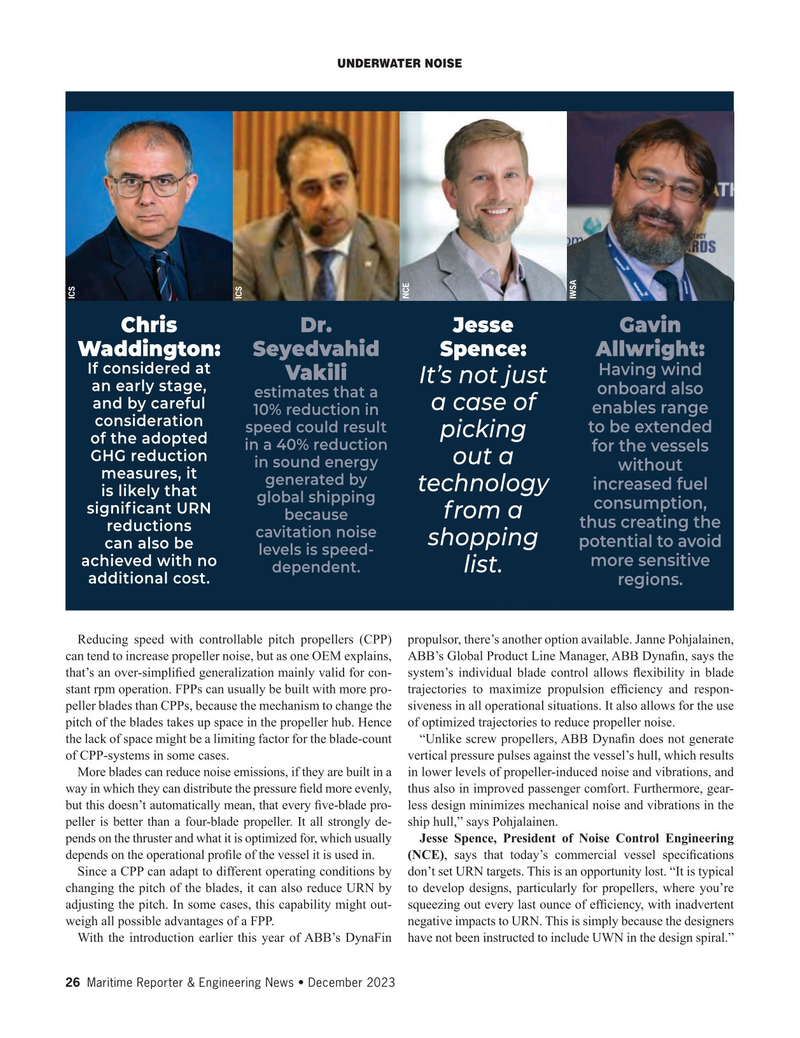
Page 26: of Maritime Reporter Magazine (December 2023)
Great Ships of 2023
Read this page in Pdf, Flash or Html5 edition of December 2023 Maritime Reporter Magazine
UNDERWATER NOISE
ICS
ICS
NCE
IWSA
Chris Dr. Jesse Gavin
Waddington: Seyedvahid Spence: Allwright:
If considered at
Having wind
Vakili
It’s not just an early stage, onboard also estimates that a and by careful a case of enables range 10% reduction in consideration to be extended speed could result picking of the adopted in a 40% reduction for the vessels
GHG reduction out a in sound energy without measures, it generated by increased fuel technology is likely that global shipping consumption, significant URN from a because thus creating the reductions cavitation noise shopping potential to avoid can also be levels is speed- achieved with no more sensitive list.
dependent.
additional cost.
regions.
Reducing speed with controllable pitch propellers (CPP) propulsor, there’s another option available. Janne Pohjalainen, can tend to increase propeller noise, but as one OEM explains, ABB’s Global Product Line Manager, ABB Dyna? n, says the that’s an over-simpli? ed generalization mainly valid for con- system’s individual blade control allows ? exibility in blade stant rpm operation. FPPs can usually be built with more pro- trajectories to maximize propulsion ef? ciency and respon- peller blades than CPPs, because the mechanism to change the siveness in all operational situations. It also allows for the use pitch of the blades takes up space in the propeller hub. Hence of optimized trajectories to reduce propeller noise.
the lack of space might be a limiting factor for the blade-count “Unlike screw propellers, ABB Dyna? n does not generate of CPP-systems in some cases. vertical pressure pulses against the vessel’s hull, which results
More blades can reduce noise emissions, if they are built in a in lower levels of propeller-induced noise and vibrations, and way in which they can distribute the pressure ? eld more evenly, thus also in improved passenger comfort. Furthermore, gear- but this doesn’t automatically mean, that every ? ve-blade pro- less design minimizes mechanical noise and vibrations in the peller is better than a four-blade propeller. It all strongly de- ship hull,” says Pohjalainen.
pends on the thruster and what it is optimized for, which usually Jesse Spence, President of Noise Control Engineering depends on the operational pro? le of the vessel it is used in. (NCE), says that today’s commercial vessel speci? cations
Since a CPP can adapt to different operating conditions by don’t set URN targets. This is an opportunity lost. “It is typical changing the pitch of the blades, it can also reduce URN by to develop designs, particularly for propellers, where you’re adjusting the pitch. In some cases, this capability might out- squeezing out every last ounce of ef? ciency, with inadvertent weigh all possible advantages of a FPP. negative impacts to URN. This is simply because the designers
With the introduction earlier this year of ABB’s DynaFin have not been instructed to include UWN in the design spiral.” 26 Maritime Reporter & Engineering News • December 2023
MR #12 (18-33).indd 26 12/5/2023 12:30:00 PM

 25
25

 27
27
